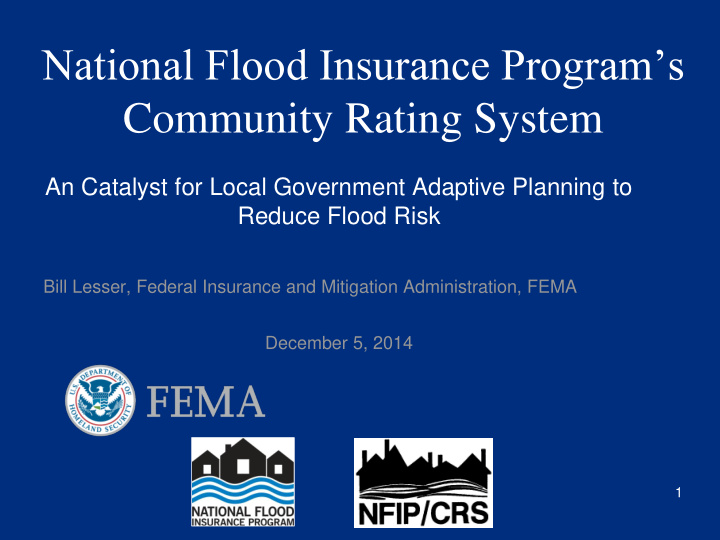



National Flood Insurance Program’s Community Rating System An Catalyst for Local Government Adaptive Planning to Reduce Flood Risk Bill Lesser, Federal Insurance and Mitigation Administration, FEMA December 5, 2014 1
National Flood Insurance Program 1. Established in 1968 2. A voluntary program based on an agreement between the Federal government and a community 3. In exchange for enforcing floodplain management regulations in the FEMA- mapped “Special Flood Hazard Area”, federally -backed flood insurance is available for purchase to property owners in the community 4. NFIP floodplain management regulations are “minimal standards broadly applicable nationwide” 5. Nearly 22,098 participating communities in the NFIP 6. 5.4 million flood insurance policies in effect nationwide 2
Community Rating System • Created in 1990 • Also voluntary • Incorporates an insurance industry practice of offering reduced premiums where floodplain management practices achieve a greater level of protection than the minimum standards of the NFIP • 1,313 participating CRS communities • 69% of all NFIP policies are in CRS communities 3
CRS Goals 1. Reduce and avoid flood damage to insurable property 2. Strengthen and support the insurance aspects of the NFIP 3. Foster comprehensive floodplain management 4
CRS Classes and Discounts Class Points SFHA Non-SFHA PRP 1 4,500 45% 10% 0 2 4,000 40% 10% 0 3 3,500 35% 10% 0 4 3,000 30% 10% 0 5 2,500 25% 10% 0 6 2,000 20% 10% 0 7 1,500 15% 5% 0 8 1,000 10% 5% 0 9 500 5% 5% 0 10 < 500 0 0 0 5
Four Series of Activities 300 Public Information 400 Mapping and Regulatory 500 Flood Damage Reduction 600 Warning and Response 19 Activities/96 elements 6
Public Information Activities • 310 Elevation Certificates • 320 Map Information Service • 330 Outreach Projects • 340 Hazard Disclosure • 350 Flood Protection Information • 360 Flood Protection Assistance • 370 Flood Insurance Promotion 7
Mapping and Regulation Activities • 410 Floodplain Mapping • 420 Open Space Preservation • 430 Higher Regulatory Standards • 440 Flood Data Maintenance • 450 Stormwater Management 8
Flood Damage Reduction and Warning and Response Activities • 510 Floodplain Management Planning • 520 Acquisition and Relocation • 530 Flood Protection • 540 Drainage System Maintenance • 610 Flood Warning and Response • 620 Levees • 630 Dams 9
Questions that come to mind... 1. How are enrollment or “sign - up” numbers? 2. What about CRS Class improvements? 3. What are the requirements for a community to join? 4. Which CRS activities get the most points? 5. Which activities are most relevant to coastal resiliency and adaptation? 6. How hard is it to become a CRS Class 6, 5 or 4? 7. Where do I go for more information? 10
Hampton Roads CRS Snapshot Accomack County - since 1992, CRS Class 8 Cape Charles, Town of – since 2010, CRS Class 9 Chincoteague, City of – since 2000, CRS Class 8 Hampton, City of – since 2011, CRS Class 8 James City County – since 1992, CRS Class 7 Norfolk, City of – since 1992, CRS Class 9 Poquoson, City of – since 1992, CRS Class 8 Portsmouth, City of – since 1992, CRS Class 9 Wachapreague, Town of – since 1996, CRS Class 9 York County – since 2005, CRS Class 8 11
12
Recommend
More recommend